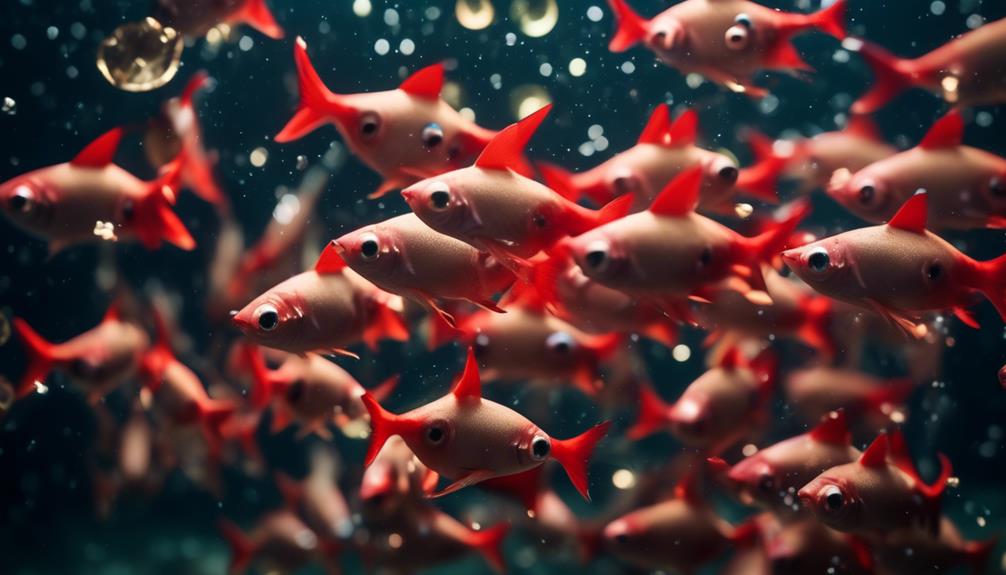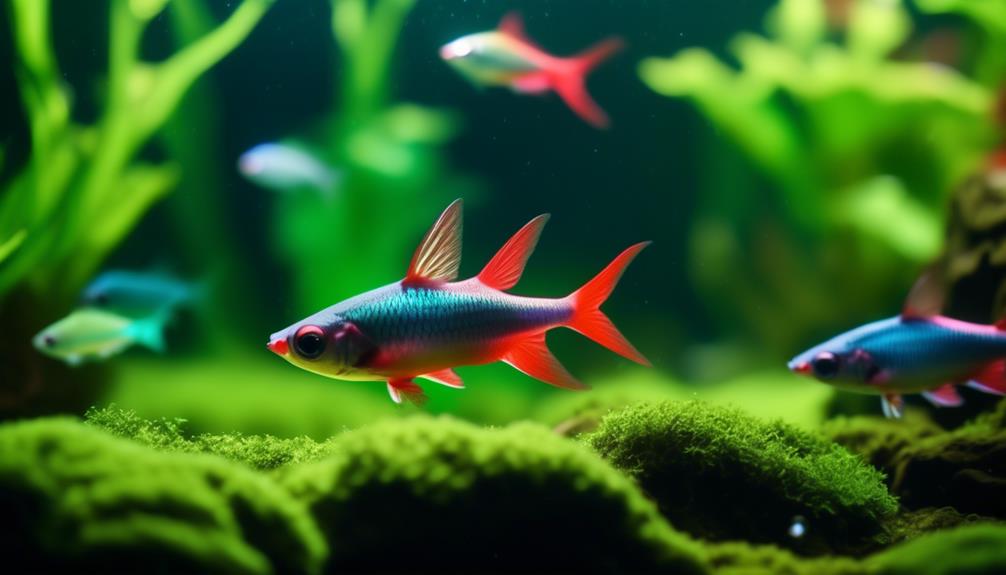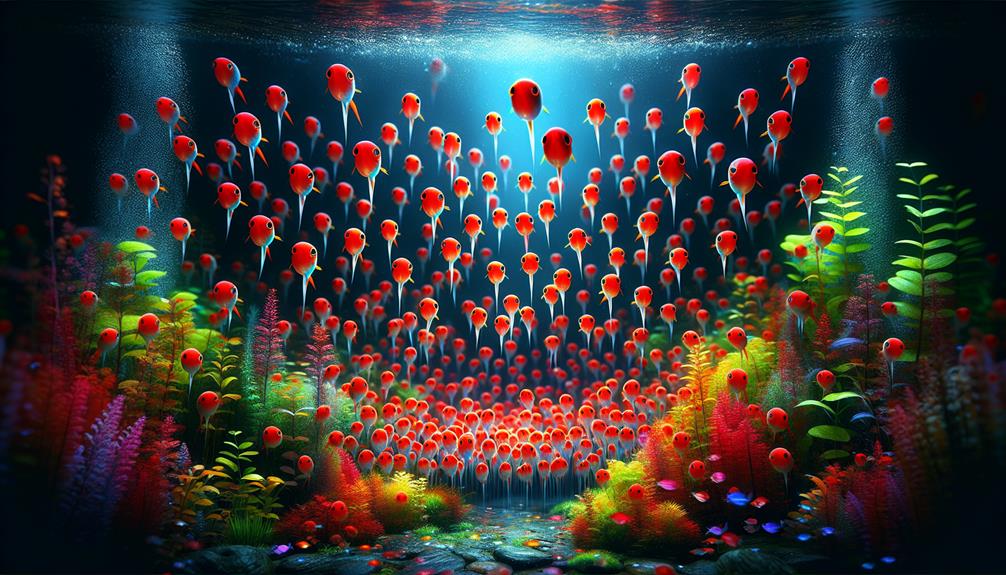The world of aquarium fish is filled with a diverse range of mesmerizing creatures, each with its own unique characteristics and behaviors. Among these, the Rummy Nose Tetra stands out as a true enigma, captivating both expert aquarists and beginners alike.
With their stunning appearance and intriguing schooling behavior, these fish have earned the title of the 'Masters of Confusion.' But what exactly makes them so mysterious? What secrets lie behind their synchronized movements and striking red-orange snouts?
In the following discussion, we will uncover the fascinating world of Rummy Nose Tetras, exploring their behavior, tank requirements, feeding habits, breeding challenges, and compatibility with other species.
So, join us on this journey as we unravel the mysteries surrounding these captivating creatures and discover what makes them the true masters of confusion in the aquatic realm.
Key Takeaways
- Rummy nose tetras have a distinctive appearance with a shiny, silvery body, red-orange snout, and white and black striping on their tail.
- They are schooling fish that tightly school together and change directions like a flock of birds, confusing predators.
- Rummy nose tetras prefer to live in warmer water temperatures and are often paired with other warm water fish.
- They require a tank with ample swimming space, hiding spots, and a biotope setup to mimic their natural environment.
Characteristics and Behavior of Rummy Nose Tetras
Rummy Nose Tetras, known for their torpedo-shaped profile, shiny silvery bodies, and distinctive red-orange snouts, exhibit fascinating characteristics and behaviors that make them intriguing subjects of study in the field of aquatic biology.
These fish are native to the Amazon River basin, where they inhabit blackwater rivers and streams. Rummy Nose Tetras are highly social and prefer to school together in groups. Their tight schooling behavior, reminiscent of a flock of birds, serves as a defense mechanism against predators, confusing them with their synchronized movements.
In their natural habitat, these tetras prefer soft and acidic water with a pH range of 5.5–7.5. They are active swimmers and require ample swimming space. Understanding the social behavior and natural habitat of Rummy Nose Tetras is crucial for providing them with suitable tank conditions and ensuring their well-being.
Tank Requirements for Rummy Nose Tetras
Tank requirements for Rummy Nose Tetras include specific water parameters and a suitable tank size to accommodate their active schooling behavior and replicate their natural habitat in the Amazon basin.
These tetras originate from blackwater rivers and streams and prefer soft and acidic water with a pH range of 5.5–7.5 and a soft to moderately hard GH.
A minimum tank size of 20 gallons or larger is recommended to provide ample swimming space for their active nature.
Maintaining a water temperature between 75-82°F (23-29°C) is ideal for these tetras.
To create a biotope setup, incorporating catappa leaves, driftwood, and botanicals can mimic their natural environment. Additionally, providing hiding spots with plants, rocks, or driftwood is essential.
Regular water changes are necessary to maintain water quality for this species.
Feeding Rummy Nose Tetras

To ensure the well-being and nutritional needs of Rummy Nose Tetras are met, it is essential to understand their dietary requirements and feeding habits.
Rummy Nose Tetras are omnivores that have a preference for smaller foods that can fit in their small mouths. Ideal food options include baby brine shrimp and nano pellets. Additionally, fish foods with naturally color-enhancing ingredients can bring out their rosy blush.
It is important to provide a variety of different food options to avoid nutrient deficiencies. Rummy Nose Tetras can be fed high-quality flake or pellet food as a staple and their diet can be supplemented with frozen or live foods such as brine shrimp or bloodworms.
Feeding small amounts multiple times a day and removing any uneaten food is crucial to maintaining water quality.
Breeding Rummy Nose Tetras
Breeding Rummy Nose Tetras requires careful attention to environmental conditions and specific breeding techniques. These tetras are generally hardy but can be susceptible to common fish diseases such as ich, fin rot, or fungal infections. Maintaining good water quality is crucial to prevent stress-related diseases. It is recommended to quarantine new fish before introducing them to the main tank to avoid any potential health issues.
Breeding Rummy Nose Tetras in captivity can be challenging. To stimulate breeding behavior, it is important to provide dim lighting and soft water conditions. Separating a breeding pair into a separate tank with fine-leaved plants for egg-laying is recommended. After spawning, the adult fish should be removed to prevent them from eating the eggs.
The fry should be fed with infusoria or powdered fry food initially. It is advised to consult a veterinarian or experienced aquarist if any health issues arise.
Compatibility and Tankmates

After successfully breeding Rummy Nose Tetras, it is important to consider their compatibility with other fish species and their suitability as tankmates. Rummy Nose Tetras are known to get along well with peaceful community fish of similar size. They can be kept with other tetras, rasboras, and corydoras. Their bold personality also makes them great dither fish for shy or territorial species.
However, it is important to note that Rummy Nose Tetras should not be kept with cooler water fish, as they prefer warmer temperatures. While they tend to leave adult dwarf shrimp and snails alone, they may eat baby shrimp and fry.
When considering tankmates for Rummy Nose Tetras, it is crucial to ensure compatibility in terms of temperament and water temperature to create a harmonious and thriving aquarium environment.
Frequently Asked Questions
Can Rummy Nose Tetras Be Kept in a Community Tank With Aggressive or Territorial Fish?
Rummy nose tetras are compatible with peaceful community fish but should not be kept with aggressive or territorial fish. Introducing them to aggressive tankmates may result in stress, aggression, and potential harm to the tetras.
What Are the Signs of a Healthy Rummy Nose Tetra?
Signs of a healthy rummy nose tetra include vibrant coloration and active swimming. They should exhibit a shiny, silvery body with a bright red nose and clear, distinct black stripe. Active, energetic behavior is indicative of good health.
How Long Do Rummy Nose Tetras Typically Live in Captivity?
Rummy nose tetras are ideal tank mates for peaceful community fish. To extend their lifespan in captivity, maintain optimal water quality, provide a balanced diet, and create a suitable environment mimicking their natural habitat.
Are Rummy Nose Tetras Prone to Any Specific Diseases or Health Issues?
Rummy nose tetras are prone to common fish diseases such as ich, fin rot, and fungal infections. Maintaining good water quality and quarantining new fish can help prevent these health issues. They coexist peacefully with other community fish of similar size.
Can Rummy Nose Tetras Be Kept in a Planted Tank With Live Plants?
Rummy nose tetras can be kept in a planted tank with live plants, providing several benefits. Live plants offer natural hiding places, improve water quality, and create a more aesthetically pleasing environment. To maintain a healthy tank, ensure proper lighting, substrate, and fertilization for the plants, and monitor water parameters regularly.
Conclusion
In conclusion, Rummy Nose Tetras are captivating freshwater fish known for their striking appearance and unique schooling behavior. With torpedo-shaped bodies, silvery hues, and vibrant red-orange snouts, they add beauty and intrigue to any aquarium.
Their tight schooling instinct serves as a clever defense mechanism against predators. By understanding their characteristics, tank requirements, feeding habits, breeding challenges, and compatibility with other fish, aquarists can create a thriving environment for these Masters of Confusion.
Embark on a journey into the mesmerizing world of Rummy Nose Tetras and witness the harmony and beauty they bring to your aquarium, akin to a symphony of underwater elegance.

